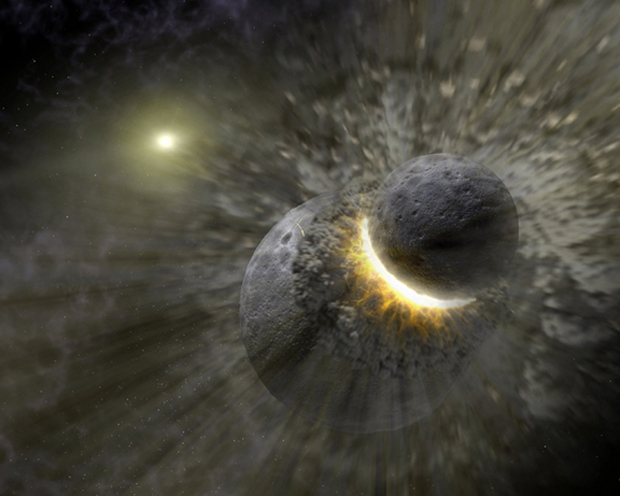Best Space Stories of the Week – Jan. 31, 2016

NASA's plan to defend Earth from asteroids, a "rogue" planet that's just misunderstood and details on the two planet pile-up that created Earth's moon — it's Space.com's top stories of the week.
A red supergiant's mystery cool
The ancient, dying star Betelgeuse is ejecting much of its mass into space, but doesn't show the increase in temperature scientists expected — so they're left wondering how this essential part of the star's life-cycle adds up. [Full Story: Dying Star Betelgeuse Keeps Its Cool ... and Astronomers Are Puzzled]
Sun particles' need for (near-light) speed
Massive solar eruptions send particles flying from the sun, but some particles go way faster than anticipated. A new study considers what might accelerate the superfast particles to near the speed of light. [Full story: Mysteriously Powerful Particles from Solar Explosions Unveiled in New Study]
Planet not 'rogue,' just far from home
An alien gas-giant, thought to fly freely through space, is actually in a system of its own — just a very, very spread out one. The planet's record-breaking orbit takes it 7,000 times further from its star than Earth is from the sun, and it takes 900,000 years to come full circle. [Full Story: Rogue Planet Finds Home in Biggest Solar System Ever Seen]
Breaking space news, the latest updates on rocket launches, skywatching events and more!
30th anniversary of NASA's Challenger disaster
Thursday marked 30 years since the space shuttle Challenger exploded just after launch, killing seven astronauts and changing the course of human spaceflight. [Full Story: Challenger Disaster 30 Years Ago Shocked the World, Changed NASA]
Ancient Jupiter-tracking tablets reveal astonishing math leap
A set of ancient Babylonian tablets used an abstract geometric technique to calculate the distance Jupiter travels — a precursor to calculus 1500 years before its time. [Full Story: Ancient Astronomy: Babylonians Used Surprising Math Leap to Track Jupiter]
Cassini prepares for epic Saturn plunge
NASA's Cassini probe has started shifting its orbit around Saturn to prepare for its Sept. 15, 2017 plunge — where it will pass under the innermost rings 22 times before falling into the planet itself. Researchers call the maneuver Cassini's "Grand Finale." [Full Story: At Saturn, Cassini Spacecraft Adjusts Orbit for Titan-ic 'Grand Finale']
Runaway star hints at explosive past
A mysterious star, stained in carbon, is flying away from the Milky Way in a super-eccentric orbit. The likely culprit: a companion star's supernova explosion. [Full Story: Strange Superfast 'Cannonball' Star Likely Blasted from Supernova]
Planet Nine 'not guilty' of extinction-level comet hurling
The newly-proposed planet orbiting far beyond Pluto, referred to as "Planet Nine," wouldn't be responsible for the periodic comet strikes that seem to hit Earth roughly every 27 million years. Some scientists suggest a far-out planet might disturb the comets orbiting in the Oort Cloud to cause such events, but Planet Nine is too small and too close by to be the culprit. [Full Story: Don't Blame 'Planet Nine' for Earth's Mass Extinctions]
(Plus, a new NASA videocautions that Planet Nine is still just an idea.)
Two-planet pileup that created the moon happened head-on
Earth and moon rocks were thoroughly scrambled before the moon separated from Earth, suggesting that the collision that caused it — a Mars-sized rock hitting Earth — was more than just a glancing blow. [Full Story: Violent Impact That Created Moon Mixed Lunar and Earth Rocks]
Ready, set — protect the Earth!
NASA's newly-announced Planetary Defense Coordination Office will synchronize detection of — and reaction to — threatening asteroids and comets that come Earth's way. [Full Story: NASA's New Planetary Defense Office Gets to Work Protecting Earth]
The fungi are all right
Two species of Antarctic fungi survived 18 months in Mars-like conditions on the International Space Station, suggesting that some of Earth's hardiest organisms might withstand the Red Planet's environment. [Full Story: Fungi Survive Mars-Like Conditions On Space Station]
Email Sarah Lewin at slewin@space.com or follow her @SarahExplains. Follow us @Spacedotcom, Facebook and Google+. Original article on Space.com.

Sarah Lewin started writing for Space.com in June of 2015 as a Staff Writer and became Associate Editor in 2019 . Her work has been featured by Scientific American, IEEE Spectrum, Quanta Magazine, Wired, The Scientist, Science Friday and WGBH's Inside NOVA. Sarah has an MA from NYU's Science, Health and Environmental Reporting Program and an AB in mathematics from Brown University. When not writing, reading or thinking about space, Sarah enjoys musical theatre and mathematical papercraft. She is currently Assistant News Editor at Scientific American. You can follow her on Twitter @SarahExplains.
